Why
Are You Standing Still?
By
John Clements
ARMA Director
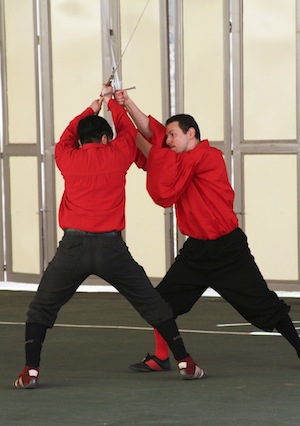 First
off, let’s establish a general theme from Renaissance source teachings: First
off, let’s establish a general theme from Renaissance source teachings:
"this is the basic tenet of swordsmanship: that a man is
always in motion and never at rest..."
– the teachings of Master Liechtenauer, c1389
"If great in this Art you want to appear, Move then you
can from guard to guard... with steps never prolonged." –
Master Filippo Vadi, c.1480
"it is good to dissimulate with the feet and hands, for
if we remain fixed they can easily injure us" – Master Pietro
Monte, c.1490
"When one in playing has doubt of the other, he must never
fix himself in a single guard, but change immediately from one into
another. The reason being that the enemy will not be able to form some
opinion." – Master Antonio Manciolino, 1531
"one [should] not rest much in some defensive guard" – D’Angelo Viggiani, 1551
"there is no doubt but he vanquisheth which is most nimble,
and this nimbleness is not obtained by handling of great hefts or weights,
but by often moving." - Master Giacomo Di Grassi, 1570
"you shall note, although there are many good postures…
yet you learn from these verses that it is always better not to entirely
settle into a posture…" – Master Joachim Meyer, 1570
"though we often chop and change, turn and return, from
ward to ward, from fight to fight… yet we never rest in any."
– Master George Silver, 1599
"It is therefore evident how dangerous it is to attempt to
resist the momentum of a cut without reaching the opponent’s body before
the cut falls." - Master Salvatore Fabris, 1606
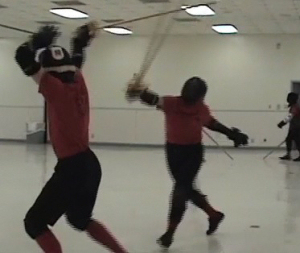 See
a pattern here? See
a pattern here?
These quotes on frequent motion and fighting positions are
hardly exhaustive of the sources, either. Besides all the various counsel
on nimble stepping and the frequent advice on striking in the middle of
the opponent’s action, there is a clear constant at work: don’t
stand still.
Find a statement by any Renaissance Master of Defense or command in any
treatise that instructs a fighter to remain inert in a guard, or resting
poised to strike. There is nothing in our historical source teachings
that advocates this or that can be used to substantiate such a conception.
For that matter, no system of non-ritualized self-defense is based on
being immobile. Try to name a single legitimate martial art style or combative
sport that teaches you to remain stationary.
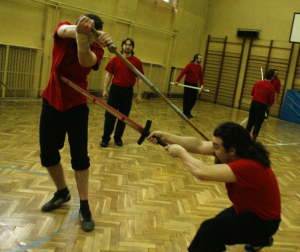 So,
why then do we see so many students of weapon arts today sparring while
keeping relatively stationary? Why do so many engaged in mock combat bouts
just stand there taking small steps as they try to tag one another? This
is an important matter to bring to attention. It’s not at all difficult
to see practitioners conduct their free-play by slowly stepping around
one another as they try to win a snapping game of timing and range. But
the sight nowadays of two historical-fencing combatants slowly inching
their way ever closer, posed like insect-brained praying mantises, is
as absurd as it is commonplace. Even a cursory review of historical fencing
websites and YouTube submissions reveals this sluggish tendency is a plague
upon much of current historical fencing practice. In my experience, as
a professional instructor of Renaissance martial arts, getting students
to act with the audacity necessary to keep the initiative is a frequent
concern. I see this even among my own students who should know better
(and caught myself doing it from time to time). So,
why then do we see so many students of weapon arts today sparring while
keeping relatively stationary? Why do so many engaged in mock combat bouts
just stand there taking small steps as they try to tag one another? This
is an important matter to bring to attention. It’s not at all difficult
to see practitioners conduct their free-play by slowly stepping around
one another as they try to win a snapping game of timing and range. But
the sight nowadays of two historical-fencing combatants slowly inching
their way ever closer, posed like insect-brained praying mantises, is
as absurd as it is commonplace. Even a cursory review of historical fencing
websites and YouTube submissions reveals this sluggish tendency is a plague
upon much of current historical fencing practice. In my experience, as
a professional instructor of Renaissance martial arts, getting students
to act with the audacity necessary to keep the initiative is a frequent
concern. I see this even among my own students who should know better
(and caught myself doing it from time to time).
What’s with this obsession over static fighting postures? We are
forced to ask where does this widespread impulse of stepping slowly while
set in a guard originate? Where does this idea come from that the nature
of close-combat (whether armed or unarmed) consists of such a thing? Since
when has "holding" a stance ever meant to pause and stand still?
There is no evidence I can find on which to support that conception.
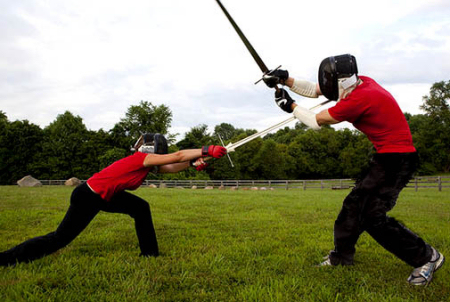 Stop
and ask someone where they first learned to practice this way. Inquire
as to how they got a style of fencing by standing still. Get them to think
about it. Press them. Dig deep. A little introspection usually leads to
an admission that it’s not based on any reasoned analysis or any
sound evaluation of a historical source. I can almost guarantee that ultimately
it will not be the result of a reasoned interpretation of actual teachings
from a Renaissance work on the Art of Defence. Rather, it will almost
typically be something they slowly acquired out of habit then just continued
without question. Even if they are consciously aware of doing it, you
will likely hear a convoluted explanation to justify it that ultimately
boils down to the stylized rules they play-fight under and the narrow
experience of the opponents they’ve restricted themselves to. Stop
and ask someone where they first learned to practice this way. Inquire
as to how they got a style of fencing by standing still. Get them to think
about it. Press them. Dig deep. A little introspection usually leads to
an admission that it’s not based on any reasoned analysis or any
sound evaluation of a historical source. I can almost guarantee that ultimately
it will not be the result of a reasoned interpretation of actual teachings
from a Renaissance work on the Art of Defence. Rather, it will almost
typically be something they slowly acquired out of habit then just continued
without question. Even if they are consciously aware of doing it, you
will likely hear a convoluted explanation to justify it that ultimately
boils down to the stylized rules they play-fight under and the narrow
experience of the opponents they’ve restricted themselves to.
We are not talking here about those brief respites and fleeting moments
of recess that intrinsically occur as skilled fighters read one another
or perceive intention, feinting and testing. It’s one thing to learn
at a slower pace but quite another to conceive that historical self-defense
in the real world occurred the same way. It's not a momentary pause when
you do it incessantly. You’re not mastering an authentic combat art
when the natural violent energy of fighting is persistently reduced to
a tip-tap timing game of mild-mannered range tag ("sword-mummery"
anyone?).
But
is this habit of standing still to sword-tag one another, as if conducting
an invisible fight at the barriers, just one of laziness that comes from
a too-playful attitude of casual practice? Or is it picked up unconsciously
merely because the historical source images show us so many inanimate
illustrations whose positions people try to imitate? Perhaps it’s
the pernicious influence of stunt fencing theory where, to avoid altering
the safety distance, performers purposely keep one or both legs firmly
in place? We also can’t ignore that virtually every modern enthusiast
simply saw it in a movie once (let's not even bring into this the pervasive
influence from the stiff ritualized patterns of katas or the frozen postures
of video game characters). After all, the staple of two lone swordsmen,
gladiators, or samurai facing off, stationary until some sudden move is
then intercepted with a lightning reflex, has long been a cliche.
It makes good drama. Never mind that it’s total fiction without any
tactical validity.
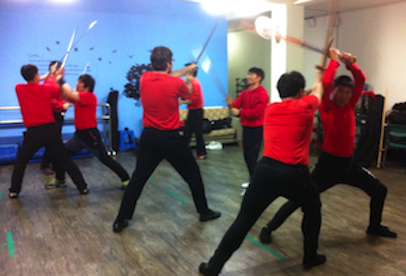 The
view that you can stay relatively motionless to "lie in wait"
for an opponent’s action is self-defeating and works only
against
novices and fools. It’s one thing to occasionally slow down your
fighting practice to enjoy it as exercise or to work on specific
elements,
but entirely another to habitually implement a low-key style
that intrinsically
lacks energy and motion. Who in their right mind imagines that
the real-life
violence of personal combat involves just moving occasionally or
only
when we detect our attacker moving? Certainly, it’s a given that
if someone today is not physically inclined to much movement or
not wanting
to take a very energetic approach to this craft, then naturally
they will
not want to see it as being anything about constant motion. Yet,
from the late 14th century teachings of the grand-fechtmeister,
Johannes Liechtenauer, we are given a cardinal rule for keeping the
initiative and staying on the offense whereby, “you are always in motion
[In motu seist] and do not rest or hold yourself back but do one thing
after another quickly and decisively so that your opponent can do
nothing at all.” [38v] The
view that you can stay relatively motionless to "lie in wait"
for an opponent’s action is self-defeating and works only
against
novices and fools. It’s one thing to occasionally slow down your
fighting practice to enjoy it as exercise or to work on specific
elements,
but entirely another to habitually implement a low-key style
that intrinsically
lacks energy and motion. Who in their right mind imagines that
the real-life
violence of personal combat involves just moving occasionally or
only
when we detect our attacker moving? Certainly, it’s a given that
if someone today is not physically inclined to much movement or
not wanting
to take a very energetic approach to this craft, then naturally
they will
not want to see it as being anything about constant motion. Yet,
from the late 14th century teachings of the grand-fechtmeister,
Johannes Liechtenauer, we are given a cardinal rule for keeping the
initiative and staying on the offense whereby, “you are always in motion
[In motu seist] and do not rest or hold yourself back but do one thing
after another quickly and decisively so that your opponent can do
nothing at all.” [38v]
But why even consider that a fighter would ever keep still or stay set
in a position? Are objective people really to believe that, despite unequivocal
commands to stay in motion and despite countless images that are unmistakably
snapshots of techniques in motion, a few example freeze-frame illustrations
defining positions for reference are somehow meant to be taken as instructing
us to hold still? (In the same vein, no one could imagine that pictures
of Ringen combatants are somehow showing fighters frozen in unarmed stances.)
Or does such a belief come about because we are told to "place"
ourselves in a stance, or figures are described as being "in postures?"
Or is it because we are told to hit an opponent when his stance is incorrect
or when he changes postures? When we read what to do if the opponent "adopts"
a stance or "stands" before us it doesn’t mean they are
literally standing there waiting (…and if for some reason
they were it would be easier to fight them). Considered in context
the examples and instructions are for combatants engaged in violent
motion—the act of fighting—not the act of posing and
playing.
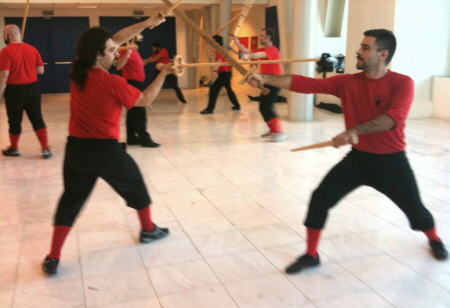 That
the historical sources teach us to break an opponent’s "stance"
or to displace the blow of an adversary who "holds" a posture
does not also imply in any way they are doing so while standing still.
Instead, implicit in the idea of "ready positions" or "wards"
is that they are dynamic, active, and prepared. Each strike lies between
two guards and each guard is itself the result as well as the beginning
of a strike. One need only examine a skilled boxer or modern fencer to
see this in action. Just as is true of any fighting discipline, both these
activities have specific fighting stances but they are never held rigid
or stationary. They move and cover almost constantly with a broken rhythm
that can explode into action at any moment. Judgment of timing, distance,
and leverage—the core elements of fighting—take place
only with regard to movement. It’s all about motion. That
the historical sources teach us to break an opponent’s "stance"
or to displace the blow of an adversary who "holds" a posture
does not also imply in any way they are doing so while standing still.
Instead, implicit in the idea of "ready positions" or "wards"
is that they are dynamic, active, and prepared. Each strike lies between
two guards and each guard is itself the result as well as the beginning
of a strike. One need only examine a skilled boxer or modern fencer to
see this in action. Just as is true of any fighting discipline, both these
activities have specific fighting stances but they are never held rigid
or stationary. They move and cover almost constantly with a broken rhythm
that can explode into action at any moment. Judgment of timing, distance,
and leverage—the core elements of fighting—take place
only with regard to movement. It’s all about motion.
From the 12 Rules for the Beginner Fencer from the late 14th century,
Der Atlen Fechter, we read Rule #3: “Strike and move at the same time,
place the feet against each other”. Rule #4 then declares: “He who moves
after the blows has no right to be proud of his art.” There is no
ambiguity to this. The body must be coordinated with arm motion by
virtue of footwork that leverages our balance —like a scale. That these
two rules for the novice fighter start first with the instruction in
rule #1 on how to stand, stating: “The leg in front is bent; the other
one going towards the back is stretched” is as unequivocal as rule #2
telling us, “Fight high with straightened body; deliver mighty blows out
of the length.” The meaning is clear: posture, footwork, and power in
cutting and trusting is inseparably linked.
This was even stressed
almost two centuries later in master Joachim Meyer’s book on the art of
fighting, when noted in Chapter 7, “Advice About Stepping”, he advise
that so much depends on stepping or footwork that: “all combat happens
vainly, no matter how artful it is, if the steps for it are not executed
correctly. He is not referring to which fighter acts first following
after some action, but rather to a fighter whose slow or dragging
footwork is not coordinated to his action. The meaning is succinct
enough from his very next lines following: “Therefore the combat masters
of old who were very learned and experienced in this, stated in their
twelve rules: “Whoever first steps after the cuts should not rejoice
much of his skill.” And as if to remove any no doubt whatsoever, he then
immediately adds: “Therefore each stroke must have its own step, which
shall take place at the same time as the stroke, if you wish to achieve
anything.” (1.24r) Meyer, who states several different ways to always
move “from one posture into another,” also finally adds at the very the
end of his home describing the entire art of the longsword the
declaration, “If you also wish to know the master core, learn to step
rightly for all techniques.” This harkens back to Liechtenauer’s central
command about the importance of continuously moving. It doesn’t mean to
just keep our hands and arms in motion or to bob our head and shoulders
around, but to move the body with the feet.
As if this was not clear enough, Master Meyerr even included a
restating of the need for footwork to be linked to blows when in his
long-sword poem. In the piece --which brilliantly summarizes the entire
Art in only a few pages-- immediately following a description of the
moral qualities of a good practitioner, the 4th line of instruction
includes the instruction that you must, "Step with the stroke, be it
near or far."
From 1509, the master, Pietro Monte, describing his knightly art of
combat (based upon the two-hand sword and the pole-axe), noted how “it
was harmful to stand fast when fighting with arms” —adding that this was
particularly with the dagger the case since you could get quickly
thrown or hurt. In his second chapter Monte notes that, “To apply great
force calls for balance with lightness and fluidity in our feet and
hands, otherwise we compromise our powers and agility, without which we
can do little.” He adds, "And always we should move our legs and arms
from place to place with the blows and with short steps.”
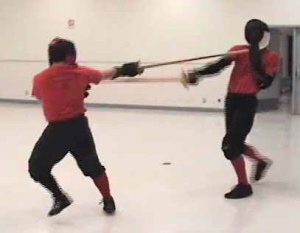 Fighting
postures are transitory (some more so than others). They are meant to
be moved through. Consider how the late 15th-century master Pietro
Monte specifically warned against entering a fight from a wholly static
stance. As Manciolino later did, Monte emphasized that no ward was entirely
safe and that if the fencer "shut" himself up in one position
he would "fall to ruin." He stressed the need to move in a way
that concealed your intentions, for, "if we temporize as to which
part we are moving, they do not know for certain what decision we are
going to take." This goes way beyond mere feinting of blows. A century
earlier Hanko Doebringer had expressed the same with the counsel: "always
be in motion, this will force the opponent to be on the defence and not
be able to come to blows himself." When we are further told "always
work and remain in motion" it hardly applies to just moving our weapon
when in range to strike. From Doebringer
we further read, "Who rests, that is dead, who moves, is still alive"
and are told to "remain fast in movement, and do not tarry." Fighting
postures are transitory (some more so than others). They are meant to
be moved through. Consider how the late 15th-century master Pietro
Monte specifically warned against entering a fight from a wholly static
stance. As Manciolino later did, Monte emphasized that no ward was entirely
safe and that if the fencer "shut" himself up in one position
he would "fall to ruin." He stressed the need to move in a way
that concealed your intentions, for, "if we temporize as to which
part we are moving, they do not know for certain what decision we are
going to take." This goes way beyond mere feinting of blows. A century
earlier Hanko Doebringer had expressed the same with the counsel: "always
be in motion, this will force the opponent to be on the defence and not
be able to come to blows himself." When we are further told "always
work and remain in motion" it hardly applies to just moving our weapon
when in range to strike. From Doebringer
we further read, "Who rests, that is dead, who moves, is still alive"
and are told to "remain fast in movement, and do not tarry."
In his work on from c.1551, D’Angelo Viggiani wrote there were
an infinitesimal number of diverse guards because in essence any
starting and ending position between the motions of a momentary strike
qualified as one: "each blow gives rise to a guard and each guard gives
rise to a blow." He added that any fighting posture was merely
the action of "lying calm and settled in some form with arms, either in
order to offend or defend, that settlement, and that position, and that
composition of the body in that guise, in that form, I call ‘guard’"
(See W. Jherek Swanger’s 2002 translation). Once again, implicit in
this understanding is that movement and not position is the basis of
fighting. This is clear enough when we read his instruction to "always
remain attentive in the stepping to seize the opportunity to place
yourself in guard with the advantage of the sword…never try to strike
unless when you throw the blow you can reach the enemy" by stepping. In
other words: move to counter-strike. There’s no instruction here
to stand still. It’s all about acting in the instance by closing
in. We can readily accept that Viggiani applies continuous motion
in his fencing since he explicitly states how "every infinitesimal
movement forms diverse guards, which movements are without number or
end." The only way to view fighting stances in that way is if you are in constant motion.
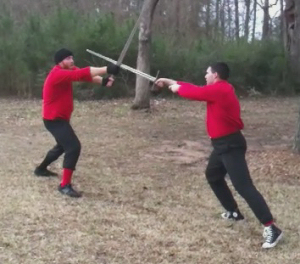 When
addressing the very concept of ready positions the 16th century master
Joachim Meyer described that, "guards or postures are a graceful
but also necessary positioning and comportment of the whole body with
the sword, in which the combatant places and positions himself when he
is the first to come to his opponent in the place of encounter…."
He immediately added that this is done at the onset of a fight
for purposes of moving to strike or defend. None of this
in any
way overrules the command to be in active motion. When Meyer
advises, "you shall pay attention, as the situation requires, to how
your
opponent poses against you" it doesn’t in any way suggest the
opponent is somehow stationary. When
addressing the very concept of ready positions the 16th century master
Joachim Meyer described that, "guards or postures are a graceful
but also necessary positioning and comportment of the whole body with
the sword, in which the combatant places and positions himself when he
is the first to come to his opponent in the place of encounter…."
He immediately added that this is done at the onset of a fight
for purposes of moving to strike or defend. None of this
in any
way overrules the command to be in active motion. When Meyer
advises, "you shall pay attention, as the situation requires, to how
your
opponent poses against you" it doesn’t in any way suggest the
opponent is somehow stationary.
On fighting postures, Meyer early on in his treatise of 1570
succinctly explains their origin and function: "And so that you may
always be more mindful of [employing the chief elements]; the postures
have arisen, which are essentially just a lingering or holding of the
weapon in the furthermost place, to which you have come in pulling up
for the stroke, so that before the cut is fully completed you still have
space in the middle of it to decide either to complete this cut
according to your first intent, or that it will be more useful to turn
it elsewhere; thus you will miss no opportunity that arises in the Vor and Nach, rather (according to the admonition of the word Indes)
you can be shrewdly mindful of every opportunity. And the postures or
guards arise from this, as I have said." This description also
explains how and why earlier works in the course of describing
techniques use phrases such as "standing in your ward" to mean the
actions and positions used in fighting, and not for the fighter to
literally hold still waiting to act.
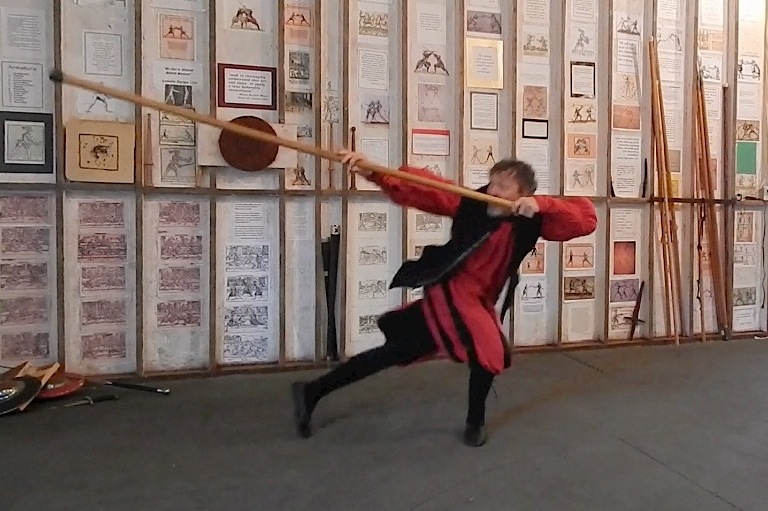 On his section "Fighting from the Postures," Meyer provided
even more edification on staying in motion as he explained specifically
how uninterrupted motion is the entire necessity of using fighting
stances: "I would not have you remain long in any of them, since they
are not invented for this purpose…" Meyer then directly explains how
the whole function of a ready position is simply for "when you draw up
your sword for a stroke" so that "you will know how to send your sword
at once quickly…" This idea of a fighting stance being merely the act
of "drawing up your sword" is critical in comprehending the importance
of constant motion and how just standing there "holding still" is the
antitheses of the Art. Meyer concludes his description of fighting from
the postures by writing unequivocally how that even as a fighter will
typically make momentary pauses in any ready posture, this occurs only
for a fleeting instance: On his section "Fighting from the Postures," Meyer provided
even more edification on staying in motion as he explained specifically
how uninterrupted motion is the entire necessity of using fighting
stances: "I would not have you remain long in any of them, since they
are not invented for this purpose…" Meyer then directly explains how
the whole function of a ready position is simply for "when you draw up
your sword for a stroke" so that "you will know how to send your sword
at once quickly…" This idea of a fighting stance being merely the act
of "drawing up your sword" is critical in comprehending the importance
of constant motion and how just standing there "holding still" is the
antitheses of the Art. Meyer concludes his description of fighting from
the postures by writing unequivocally how that even as a fighter will
typically make momentary pauses in any ready posture, this occurs only
for a fleeting instance:
"the
reason that even experienced fighters sometimes longer in a guard,
namely that you not only should undertake no cut or stroke
thoughtlessly, but also that after you have pulled up and gathered
yourself for this stroke, and at that moment shall send the stroke
farther, you shall linger in that furthermost point for just a bit,
almost only for the blink of an eye, to reconsider whether it is worth
completing your intended stroke, or whether in the mean time a better
opportunity has arisen for you, so that you should change it…"
There can be no question of the understanding Meyer offered
the reader for how stances are never meant to ever be stationary and
held static but only used in the briefest of transitory instances,
since he concludes by revealing: "This is the chief cause of the
invention of the postures, and therefore he who sometimes lies in a
posture should see what the intention of the other one is, so that he
may know netter how to catch him…" (Meyer, 75-76) As if to
further emphasize the fluidity of stances and the continuous dynamic
motion that makes up fighting, Meyer even instructed that: "you shall
fully fix in your mind the techniques that are appointed for every
posture, practice them, and make them familiar to you, so that as you
come into a posture in the middle of the fight, you are ready and
prepared with counter techniques."
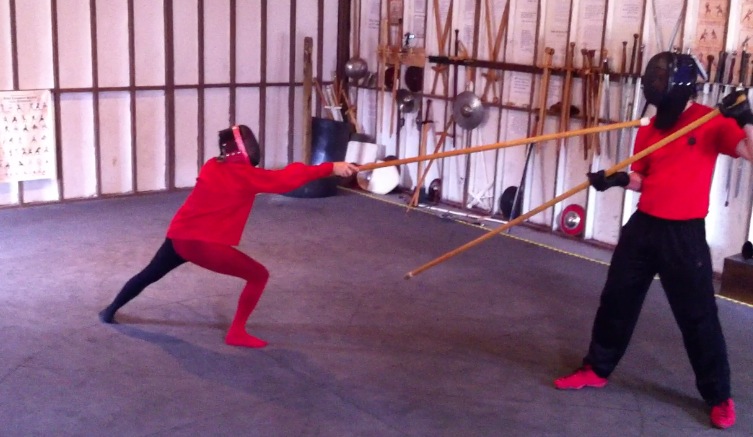 Of
fighting postures, the master Giacomo Di Grassi wrote in his 1570
work that, "Wards in weapons are such sites, positions or
placings
which withstand the enemy’s blows, and are as a shield or
safeguard
against them." Di Grassi stressed the importance of movement,
saying, "Most great is the care and considerations which the paces or
footsteps
require in this exercise, because from them in a manner more
than from
any other thing springeth all offence and defence." In fighting
actions, "the foot ought to agree chiefly in motion with the hand" he
declared. Of
fighting postures, the master Giacomo Di Grassi wrote in his 1570
work that, "Wards in weapons are such sites, positions or
placings
which withstand the enemy’s blows, and are as a shield or
safeguard
against them." Di Grassi stressed the importance of movement,
saying, "Most great is the care and considerations which the paces or
footsteps
require in this exercise, because from them in a manner more
than from
any other thing springeth all offence and defence." In fighting
actions, "the foot ought to agree chiefly in motion with the hand" he
declared.
In his
section on "Paces" or footwork, Di Grassi specifically criticized
fighters who don’t move enough and try to fight by just reaching outward
with their arms but not stepping: "For when it happens that he may
strongly offend his enemy without the increase of a pace, he must use
his arm only to perform the same, bearing his body always as much as he
may and is required, firm and immovable. For this reason I commend not
their manner of fight, who continually as they fight, make themselves to
show sometimes little, sometimes great, sometimes wresting themselves
on this side, sometimes on that side, much like the moving of snails."
But, Di Grassi
also warned of extraneous motion: "As concerning the motion of
the
feet, from which grow great occasions as well of offense as
Defense, I
say and have seen by diverse examples that as by the knowledge
of their
orderly and discreet motion, as well in the lists as in common
frays,
there has been obtained honorable victory, so their busy and
unruly motion
have been occasion of shameful hurts and spoils." Proper
movement
is always disciplined. Hanko Doebringer had earlier addressed
this in 1389 when
he cautioned, "in this righteous fencing do not make wide or
ungainly
parries or fence in large movements by which people restrict
themselves."
Early in his 1594 rapier treatise, Vincentio Saviolo instructed, "you
may frame your hand, your foot, and your body, all which parts must go
together, and unless you can stir and move all these together, you shall
never be able to perform any great matter, but with great danger."
Saviolo was surely not just saying to move these elements as
necessary, but rather to move them together continuously.
Even the master George Silver in his famous 1599, Paradoxes of Defence,
described, "The grounds or Principles of true fight with all manner of
weapons" listed not only "motion" but specifically "continual
motion" among his first dozen elements of effective fighting. Writing
on the necessity of both cutting and thrusting with the sword, Silver
declared, "In fight(ing) there are many motions, with the hand, body,
and feet…" while later adding that in dagger fighting "you must use
continual motion so shall he not be able to put you to the close or
grip." When considered with his statement that we don't remain in
any one guard, his teachings are entirely consistent with the others.
You cannot follow Silver’s method by holding wards while standing still. In his second work, Brief Instructions,
Silver mentions instructs that with our motions we are to force the
opponent to react by, "changing yourself into sundry kinds of blows
thrusts and lyings, which you must not stay upon." At one point Silver
even describes how the fighter “...in the continual motion and traverses
of his ground he is to traverse circularly, forwards, backwards, upon
the right hand, and upon the left hand...” In his concise
section on fighting dagger against dagger, Silver is very specific about
the need value of maintaining your movement: "In this dagger fight, you
must use continual motion so shall he not be able to put you to the
close or grip, because your continual motion disappoints him of his true
place, and the more fierce he is in running in, the sooner he gains you
the place, whereby he is wounded, and you not anything the rather
endangered." He adds that, "The manner of handling your continual motion
is this, keep out of distance and strike or thrust at his hand, arm,
face or body, that shall press upon you, and if he defends blow or
thrust with his dagger make your blow or thrust at his hand…" He then
reminds us how all movement follows basic fighting principles, writing,
"that you use continual motion in your progression and regression
according to your twofold governors." Finally, Silver ends his Brief
Instructions by noting a general rule that, "Your hand and feet in good
play must go together, whether it is in quick or in slow motion." Finally,
Silver ends his Brief Instructions by noting a general rule that, “Your
hand and feet in good play must go together, whether it is in quick or
in slow motion.” Thus, there can be no question that, by emphasizing
movement, George Silver’s method of defense is at all times active and
dynamic.
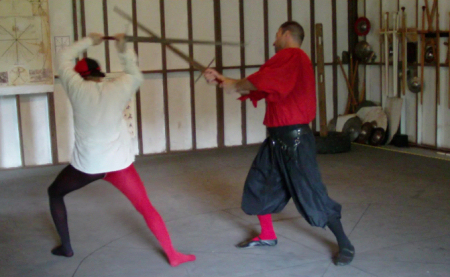 Of
movement itself, the master Fiore dei Liberi in 1410 tells us rather
directly that, "there are four things in the Art, which are passing,
turning, advancing and retreating." Again, nothing is static. It’s all
about keeping on the move. This subtext so permeates the works we study
as to be ubiquitous. Remarkably, in Chapter 30 of his Paradoxes, George
Silver virtually quoted Master Fiore when wrote that, "there belongeth
unto this Art of defence only to be used with the feet -- progression,
regression, traversing, and treading of grounds." Master Fiore at one point even goes out of his way
to say he is so good at audaciously intercepting his opponent's action
that if he so wanted to he could do it even without moving his feet,
implying that normally one readily does. Movement is also what the master
Fillipo Vadi meant when in 1480 he declared, "Be always matched with
your enemy while moving, attacking or defending, and what I say never
forget: as soon as you see his sword begin to move, or if he moves, or
even if he attacks, go back or let him find you near." (Can anyone
seriously find in this a command that it's okay to remain
stationary?) Even Girard Thibault, who in his famous early 17th
century rapier treatise stressed understanding of leverage and timing
employed with grace and speed, noted that everything came down to
moving: "All the practice of our exercise, therefore, is such that one
will always press upon the enemy… unless the opponent comes forward
himself, and thus relieves us of the trouble." Of
movement itself, the master Fiore dei Liberi in 1410 tells us rather
directly that, "there are four things in the Art, which are passing,
turning, advancing and retreating." Again, nothing is static. It’s all
about keeping on the move. This subtext so permeates the works we study
as to be ubiquitous. Remarkably, in Chapter 30 of his Paradoxes, George
Silver virtually quoted Master Fiore when wrote that, "there belongeth
unto this Art of defence only to be used with the feet -- progression,
regression, traversing, and treading of grounds." Master Fiore at one point even goes out of his way
to say he is so good at audaciously intercepting his opponent's action
that if he so wanted to he could do it even without moving his feet,
implying that normally one readily does. Movement is also what the master
Fillipo Vadi meant when in 1480 he declared, "Be always matched with
your enemy while moving, attacking or defending, and what I say never
forget: as soon as you see his sword begin to move, or if he moves, or
even if he attacks, go back or let him find you near." (Can anyone
seriously find in this a command that it's okay to remain
stationary?) Even Girard Thibault, who in his famous early 17th
century rapier treatise stressed understanding of leverage and timing
employed with grace and speed, noted that everything came down to
moving: "All the practice of our exercise, therefore, is such that one
will always press upon the enemy… unless the opponent comes forward
himself, and thus relieves us of the trouble."
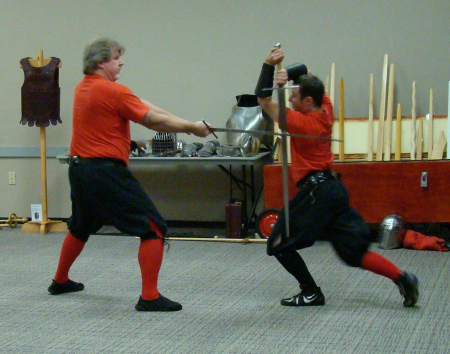 It’s
one thing while practicing to occasionally adopt a subdued manner out
of complacency (or even total ignorance of the nature of real violence),
but quite another to knowingly and deliberately defy explicit the historical
teachings. There is no getting around that the sources instruct us to
actively move and never hold still. On this they are unambiguous. It is
not a matter of alternative arguments to consider or contradictory interpretations
to debate. Either you move and stay active or else you reduce it to a
form of sword tagging. After all, "form" is not about mechanically
copying the positions in illustrations as if trying to "strike a
pose." Form exists only within the context of combative actions to
either ward off or deliver violent blows and techniques. All of this is
a function of energetic motion. Since people today are not doing this
craft for the necessity of real self-defense it’s easy to fall into
a self-delusional trap that an authentic historical mental and physical
discipline is being earnestly followed merely because historical techniques
and poses are being emulated. But there is more to reconstructing these
methods and applying their principles than prancing and dancing in non-lethal
recreational play. It’s
one thing while practicing to occasionally adopt a subdued manner out
of complacency (or even total ignorance of the nature of real violence),
but quite another to knowingly and deliberately defy explicit the historical
teachings. There is no getting around that the sources instruct us to
actively move and never hold still. On this they are unambiguous. It is
not a matter of alternative arguments to consider or contradictory interpretations
to debate. Either you move and stay active or else you reduce it to a
form of sword tagging. After all, "form" is not about mechanically
copying the positions in illustrations as if trying to "strike a
pose." Form exists only within the context of combative actions to
either ward off or deliver violent blows and techniques. All of this is
a function of energetic motion. Since people today are not doing this
craft for the necessity of real self-defense it’s easy to fall into
a self-delusional trap that an authentic historical mental and physical
discipline is being earnestly followed merely because historical techniques
and poses are being emulated. But there is more to reconstructing these
methods and applying their principles than prancing and dancing in non-lethal
recreational play.
For some it's far easier to criticize than to lead. Whereas
for us, we want to make people better fighters using the most accurate
understanding possible of the source teachings. One cannot ignore
the cardinal rules of fighting which underlie everything else in the
historical teachings. You certainly cannot ignore one set of
instructions while then consecrating other lesser ones out of all
importance. There are two simple laws of self-defense governing this matter: 1. It's
harder to hit a moving target. 2. It's easier to strike forcibly while
in motion than doing so from stillness. To argue otherwise is to reason
counter to the self-defense methods and doctrines developed from
thousands of years of human experience.
So, if you are serious about safely conducting
genuine Renaissance martial arts, about realistically reconstructing
their self-defense methods, it must be asked: why are you standing still?
"Frequens Motus [constant motion] holds the beginning, middle
and the end
of all fencing according to this art and teaching…
Motion,
this beautiful word, is the heart of swordsmanship
and the crown of the
whole matter..."
"But before all things, remember that you should not remain too long in one guard.
Liechtenauer has a saying 'He who is still is dead, he who moves will live.'
And from these guards comes the understanding that you should move in swordplay,
and not wait in a guard and thus waste your chance."
– the teachings of Master Liechtenauer, c1389
*Personally, I have for years now written extensively
about the importance of training and practicing with proper intent
(realistic physical and mental effort), the impact of "core assumptions"
on study, as well as the effect of one’s motive, objective and method
on the process. This emphasis on active movement is no less important.
A reason the ARMA has successfully unlocked so many elements of this craft
is precisely because of our committed focus during training on moving
in with proper energy, force, and speed. 2014.
|

